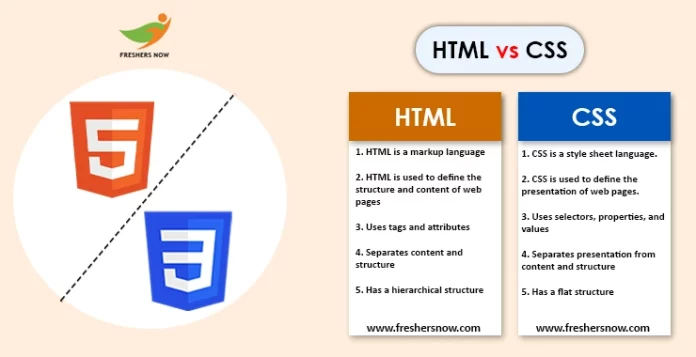
Differences Between HTML and CSS: HTML (Hypertext Markup Language) and CSS (Cascading Style Sheets) are the two fundamental technologies used in web development. While HTML is used for creating the structure and content of a web page, CSS is used for styling and layout. Understanding the Difference Between HTML and CSS is crucial for any web developer to create visually appealing and responsive web pages.
Difference Between HTML and CSS
In this article, we will explore the Top 50 Differences Between HTML and CSS, highlighting the key variances and similarities between these two technologies. So, whether you’re a beginner or an experienced developer, read on to gain an in-depth understanding of the Differences Between HTML and CSS, and how they complement each other in building modern web applications.
HTML Vs CSS | What is the difference?
What is HTML?
HTML, short for Hypertext Markup Language, is the standard markup language used to create web pages and other types of electronic documents. It was first developed in 1989 by Tim Berners-Lee, the inventor of the World Wide Web, and has since gone through several revisions to become the widely adopted language it is today. HTML allows developers to structure text, images, videos, and other types of content into a format that can be displayed in a web browser. It uses a system of tags and attributes to define the structure and layout of a document, and these tags can be combined with other web technologies such as CSS and JavaScript to create dynamic and interactive web pages. HTML is a fundamental skill for web development, and learning it is often the first step for anyone looking to create websites or web applications.
What is CSS?
CSS, short for Cascading Style Sheets, is a styling language used to describe the presentation of web pages written in HTML and other markup languages. It was first developed in 1996 by Håkon Wium Lie and Bert Bos and has since become an essential tool for web development. CSS allows developers to define the layout, fonts, colors, and other visual elements of a web page, separate from the content of the page itself. This separation of concerns allows for easier maintenance and faster load times since the presentation information can be cached separately. CSS works by targeting specific HTML elements and applying rules that define how they should look and behave. These rules can be cascaded, meaning that more specific rules override more general ones, allowing for greater flexibility in design. CSS is often used in conjunction with other web technologies such as HTML and JavaScript to create dynamic and interactive web pages. Overall, CSS is a powerful tool for web developers looking to create visually appealing and well-structured web pages.
Top 50 Differences Between HTML and CSS
HTML and CSS are two distinct languages used in web development. While HTML is used for content creation, CSS is used for styling and layout design. Here are Top 50 Differences Between HTML and CSS.
| Serial No. | HTML | CSS |
|---|---|---|
| 1 | Stands for Hyper Text Markup Language | Stands for Cascading Style Sheets |
| 2 | Used to define the structure of web content | Used to define the presentation of web content |
| 3 | Consists of tags and attributes | Consists of selectors and declarations |
| 4 | Focuses on content and its meaning | Focuses on the visual appearance of content |
| 5 | Provides semantic meaning to the content | Provides the style or design to the content |
| 6 | Used to create headings, paragraphs, and lists | Used to create color, font, and layout of web content |
| 7 | Used to create links and images on web pages | Used to add background images and adjust their positions |
| 8 | Used to add tables to web pages | Used to position and layout web page elements |
| 9 | Can be used to create forms and input fields | Can be used to create animations and transitions |
| 10 | HTML elements describe the content of a page | CSS styles describe the look and formatting of a page |
| 11 | HTML code provides the structure of a website | CSS code provides the presentation of a website |
| 12 | HTML code can be written without CSS | CSS code cannot be written without HTML |
| 13 | HTML can be used without CSS for basic design | CSS is necessary to create modern, visually appealing designs |
| 14 | HTML is used to create the skeleton of a page | CSS is used to flesh out the design of a page |
| 15 | HTML provides semantic structure to content | CSS provides the visual styling of content |
| 16 | HTML is used for defining content hierarchy | CSS is used for defining content style |
| 17 | HTML is used for creating web page layouts | CSS is used for positioning and styling web page elements |
| 18 | HTML defines the functionality of a web page | CSS defines the presentation of a web page |
| 19 | HTML is used for content organization | CSS is used for content styling |
| 20 | HTML is used for content accessibility | CSS is used for content aesthetics |
| 21 | HTML does not provide visual styles by default | CSS is needed to style HTML elements |
| 22 | HTML provides the basic structure of a webpage | CSS adds the visual elements to that structure |
| 23 | HTML focuses on the content of a webpage | CSS focuses on the design and presentation of a webpage |
| 24 | HTML is responsible for the semantic meaning of a webpage | CSS is responsible for the visual appearance of a webpage |
| 25 | HTML is used to create headings, paragraphs, and other textual content | CSS is used to modify the font, color, and layout of text content |
| 26 | HTML tags are used to identify the type of content | CSS selectors are used to target specific HTML elements |
| 27 | HTML is used for defining the basic structure of a webpage | CSS is used for defining the style and layout of a webpage |
| 28 | HTML is used to create static web pages | CSS is used to make web pages dynamic and interactive |
| 29 | HTML is used to create static web pages | CSS is used to make web pages dynamic and interactive |
| 30 | HTML code can be written using plain text editor | CSS code can also be written using a plain text editor |
| 31 | HTML can be used to create simple web pages | CSS is necessary to create visually appealing and modern web pages |
| 32 | HTML can be used to create complex web applications | CSS can be used to create complex and interactive web applications |
| 33 | HTML is used to structure and organize content | CSS is used to style and layout that content |
| 34 | HTML tags provide the structure of a web page | CSS styles provide the visual appearance of a web page |
| 35 | HTML provides basic formatting for web pages | CSS provides advanced formatting for web pages |
| 36 | HTML is used for creating web page content | CSS is used for creating web page layouts |
| 37 | HTML is a markup language | CSS is a style sheet language |
| 38 | HTML is used to add text, images, and multimedia to web pages | CSS is used to add style and layout to web pages |
| 39 | HTML provides the framework for a web page | CSS provides the design for a web page |
| 40 | HTML is used for creating the skeleton of a webpage | CSS is used for creating the look and feel of a webpage |
| 41 | HTML is a language for creating structured content | CSS is a language for creating visual presentation of that content |
| 42 | HTML can be used to create responsive web pages | CSS is used for creating responsive designs |
| 43 | HTML is used to define the hierarchy of a webpage | CSS is used to define the visual hierarchy of a webpage |
| 44 | HTML is used to create the structure of a webpage | CSS is used to add the aesthetics to the structure |
| 45 | HTML is used to add semantic meaning to web content | CSS is used to add visual style to web content |
| 46 | HTML tags can be nested | CSS rules can be combined and cascaded |
| 47 | HTML can be used for creating web forms | CSS can be used for styling web forms |
| 48 | HTML can be used to create multimedia-rich web pages | CSS can be used to create multimedia-rich web page designs |
| 49 | HTML is used to create accessible web content | CSS is used to enhance the visual appeal of web content |
| 50 | HTML provides the basic structure of a webpage | CSS enhances the user experience by adding interactivity and animation to web pages |
Conclusion: HTML Vs CSS
HTML and CSS are both essential tools for web development, but they have distinct functions and purposes. HTML provides the structure and content of a web page, while CSS controls the presentation and visual styling. Understanding the differences between HTML and CSS is crucial for creating well-designed and functional websites. By using HTML to structure the content and CSS to style and format it, developers can create web pages that are both visually appealing and user-friendly. While both HTML and CSS are constantly evolving, having a strong foundation in their basic differences will allow developers to stay ahead of the curve and create engaging and dynamic web experiences for users.
We hope that you find the comprehensive details provided here on the Top 50 Differences Between HTML and CSS satisfactory. To stay updated with the latest developments, do follow freshersnow.com.



